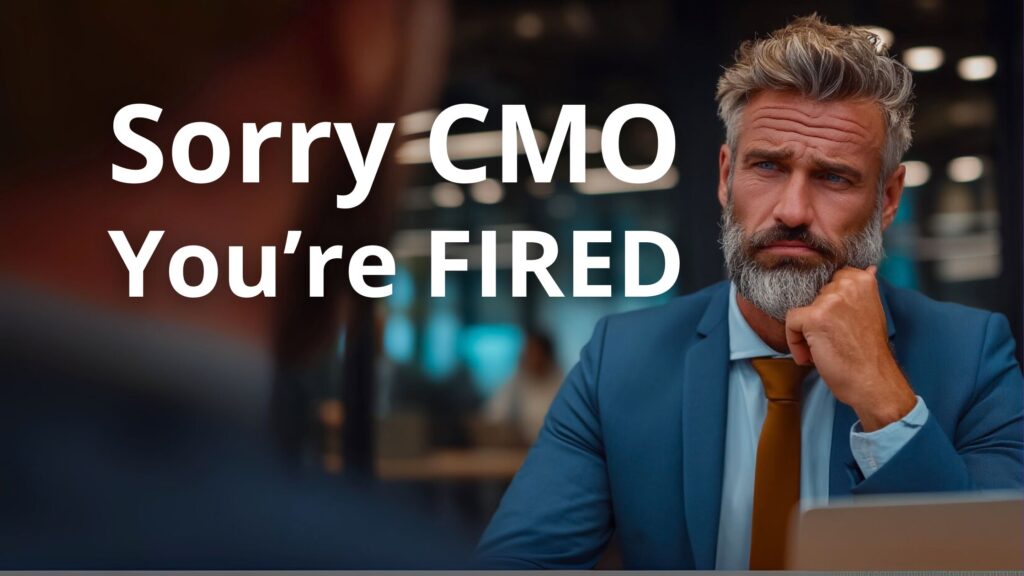Chief Marketing Officers are in trouble but there is a solution.
CMO tenure is at its lowest point in over a decade. According to Spencer Stuart’s 2024 CMO Tenure Study, the average CMO stays in the role for just 3.1 years, down from 3.5 the year before. Compare that to CEOs, who average over 7 years in the role. That gap isn’t just wide, it’s a warning.
Why are CMOs getting pushed out? One major reason is this: Boards don’t see them as contributors to revenue. And in any business climate, that’s a career-killing perception.
That’s why I wrote CASH: The 4 Keys to Better Sales, Smarter Marketing, and a Supercharged Revenue Machine. I didn’t write it to pat marketers on the back. I wrote it to help CMOs keep their jobs.
And if you’re a CMO reading this, here’s what I want you to understand:
You’re Not Being Judged by Creativity; You’re Being Judged by Contribution
Some CMOs know this, yet they still allow themselves to be measured by creative metrics. And that includes activities tied to creative activities. Marketing can no longer justify itself with traffic, brand awareness, or awards. CMOs are being judged by revenue contribution, pipeline influence, and customer lifetime value.
As I wrote in CASH:
“There is one thing marketers do the most that hurts how they are viewed by the business world: reporting on vanity metrics that do not roll up into the bottom line.” – A. Lee Judge
Vanity metrics are the death knell. Your board doesn’t care how many people watched your video, they care whether those people turned into customers. Does that mean you don’t need video? Absolutley not. But it does mean that the numerical success of your content programs are NOT the same numbers that you hang your hat on when you go into an executive meeting.
The Boardroom Speaks Revenue. Do You?
Marketing leaders must speak the language of financial impact. If you can’t show how your marketing campaigns affect revenue, margins, or sales velocity, you will always be on the chopping block when budgets get tight.
“To shift from a cost to a profit center, marketers must deepen their engagement with the sales cycle, using metrics that resonate with sales outcomes.” – A. Lee Judge
This means moving from reporting “likes” to reporting funnel velocity, customer acquisition cost (CAC), and pipeline acceleration.
View these KPI equations that get Marketers talking like Revenue Leaders
Revenue Per Marketing Investment (RPMI)
Revenue Growth from Target Accounts
Funnel Velocity
Sales Cycle Acceleration
Customer Retention Rate
Customer Expansion
Marketing Sourced Pipeline
Marketing Influenced Pipeline
Market Share Growth
Other Supportive KPIs
You Must Align with Sales (and the CFO)
This is non-negotiable. Marketing can’t afford to operate in a silo while Sales is fighting to close deals. You must align your goals, your reporting, and your strategy to help close business.
“Marketing must be acknowledged as a key part of the revenue generation process… though Sales may reel in the catch, Marketing ensures there’s always a bountiful stream from which to fish.”
Shared KPIs like SQLs, CLTV, and win rate improvement are the glue. And if you’re not meeting regularly with your CFO to understand what happens with customer “after” the sale, you’re flying blind.
You’re Not a Cost Center – So Stop Acting Like One
One of my favorite stories from CASH is about the previous marketing team that left behind a box of plastic pork chops. It is a mystery what they were used for, but there was obviously some creative marketing promotion behind them. Unfortunatley, that’s all the Sales team remembered them for; trade shows and cheap trinkets.
If that’s what your team is known for, then the perception is already cemented: you’re an expense, not an investment. You cost money rather than make it.
“The team… was viewed by Sales as the group that made T-shirts, planned trade shows, and bought tchotchkes… All cost center.”
Your job is to change that narrative.
Attribution Is Messy But It’s Not Optional
Is perfect attribution possible? No. But that doesn’t give you permission to ignore it. In reality, no one marketing campaign, and no one department is ever responsible for a sale. Not only Marketing, and not only Sales. It takes both teams and often multiple campaigns to close a deal.
“Multitouch attribution… is complex and nearly impossible to thoroughly achieve; therefore fewer companies can use it.”
Marketers and their leaders are tempted to nail down where a deal came from. They want to attribute one deal to one action. The concept of attribution has roots in an era when we could track a click to a close.
That time has passed and it is rare to impossible to do that today. Still, you must work to understand what activities are working. To do this, use directional data. Look at what activies lift the tide or give clues to success. Tie marketing activity to sales where you can. And be honest about what’s working and what isn’t.
The Hard Truth: If You Can’t Prove Value, You’re Replaceable
In 2024, Gartner reported that average marketing budgets fell to 7.7% of overall company revenue, down from 9.1% in 2023 – based on a survey of 395 CMOs and marketing leaders.
This means they are asked to do more with less.
However they don’t just want more activity, they want outcomes. Results. Revenue.
And if you can’t deliver, someone else will.
What CASH Helps You Do
The CASH framework – Communication, Alignment, Systems, and Honesty was built to address exactly this problem. It gives CMOs a roadmap to evolve:
- From metrics to meaning
- From activity to attribution
- From creative lead to strategic revenue partner
Because if CMOs are going to survive, and thrive, they need to lead the Revenue Team, not just sit at the kids’ table.
“By embedding marketing activities within the sales narrative and calibrating strategies to amplify the sales process, Marketing enhances their strategic value.”
Final Thought: Your Job Is to Protect the Seat
As a CMO, your real job is to protect the seat. That means keeping your place at the table by proving you belong there. With the right alignment, systems, and honest reporting you do.
That’s why I wrote CASH. Not for marketers who want to play it safe, but for CMOs who are ready to secure their future by showing real impact.
Let’s stop being surprised when the boardroom cuts the role. And start giving them a reason to keep us there.



